radio Lancia Delta 2011 Owner handbook (in English)
[x] Cancel search | Manufacturer: LANCIA, Model Year: 2011, Model line: Delta, Model: Lancia Delta 2011Pages: 290, PDF Size: 8.36 MB
Page 21 of 290

20KNOWING YOUR CAR
Particularly strong radio frequency interfer-
ence may cause the T.P.M.S. system to func-
tion incorrectly. This condition is indicated
to the driver by a message (for versions/markets
where provided).
The message will disappear automatically as soon
as the interference ceases to disturb the system.
Exterior lights failure (amber)
This warning light (or symbol on the display)
switches on when a failure is detected in any
of the following lights:
❍side lights;
❍brake lights (for versions/markets where provided);
❍rear fog lamps;
❍direction indicators;
❍number plate lights;
❍day lights.
The failure relating to these lights could be: one or more
blown bulbs, a blown protection fuse or a break in the
electrical connection.
The display shows the dedicated message.
W
Rear fog lamps (amber)
The warning light switches on activating the
rear fog lamps.
4
Front fog lights (green)
The warning light comes on when the front fog
lights are turned on.
5
Direction indicators
(green – intermittent)
The warning lights switch on when the direc-
tion indicator control lever is moved down-
wards, upwards or when the hazard warning
light button is pressed.
F
D
Day lights/dipped beam headlights
(green)
This warning light switches on when the day
lights or dipped beam headlights are activated.
Follow me home
This warning light comes on when this device is activated
(see “Follow me home”).
The display will show a dedicated message.
3
Page 26 of 290
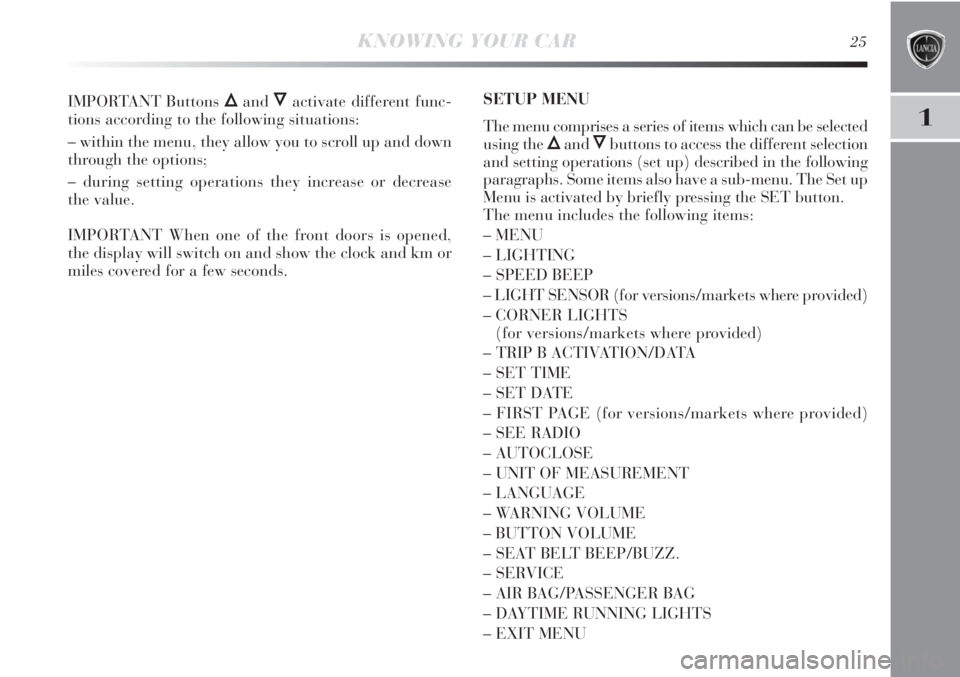
1
KNOWING YOUR CAR25
IMPORTANT Buttons ÕandÔactivate different func-
tions according to the following situations:
– within the menu, they allow you to scroll up and down
through the options;
– during setting operations they increase or decrease
the value.
IMPORTANT When one of the front doors is opened,
the display will switch on and show the clock and km or
miles covered for a few seconds.SETUP MENU
The menu comprises a series of items which can be selected
using the
ÕandÔbuttons to access the different selection
and setting operations (set up) described in the following
paragraphs. Some items also have a sub-menu. The Set up
Menu is activated by briefly pressing the SET button.
The menu includes the following items:
– MENU
– LIGHTING
– SPEED BEEP
– LIGHT SENSOR (for versions/markets where provided)
– CORNER LIGHTS
(for versions/markets where provided)
– TRIP B ACTIVATION/DATA
– SET TIME
– SET DATE
– FIRST PAGE (for versions/markets where provided)
– SEE RADIO
– AUTOCLOSE
– UNIT OF MEASUREMENT
– LANGUAGE
– WARNING VOLUME
– BUTTON VOLUME
– SEAT BELT BEEP/BUZZ.
– SERVICE
– AIR BAG/PASSENGER BAG
– DAYTIME RUNNING LIGHTS
– EXIT MENU
Page 31 of 290
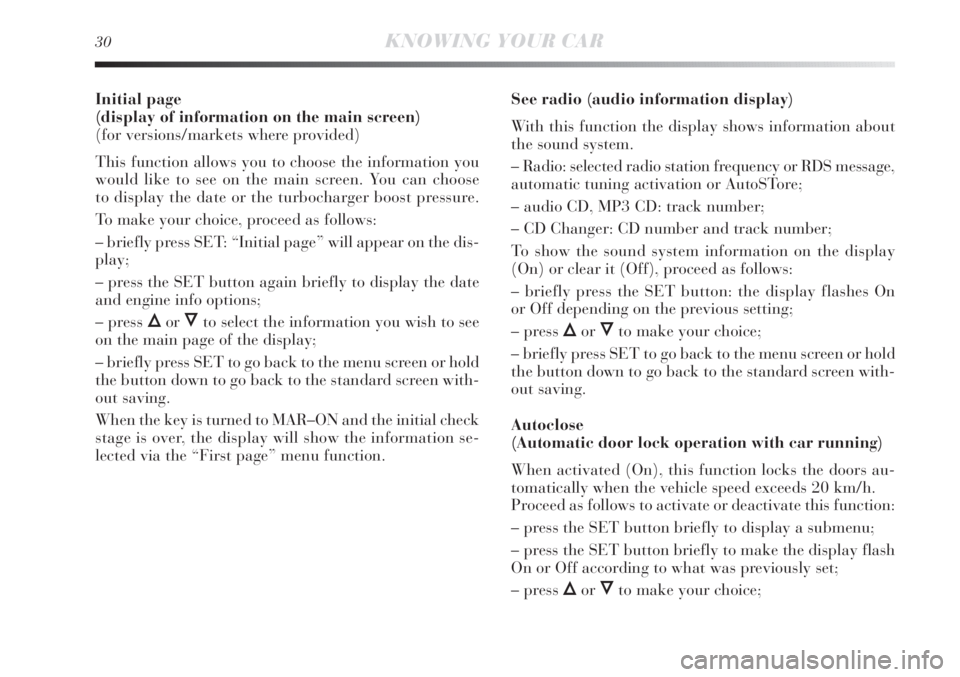
30KNOWING YOUR CAR
Initial page
(display of information on the main screen)
(for versions/markets where provided)
This function allows you to choose the information you
would like to see on the main screen. You can choose
to display the date or the turbocharger boost pressure.
To make your choice, proceed as follows:
– briefly press SET: “Initial page” will appear on the dis-
play;
– press the SET button again briefly to display the date
and engine info options;
– press
ÕorÔto select the information you wish to see
on the main page of the display;
– briefly press SET to go back to the menu screen or hold
the button down to go back to the standard screen with-
out saving.
When the key is turned to MAR–ON and the initial check
stage is over, the display will show the information se-
lected via the “First page” menu function.See radio (audio information display)
With this function the display shows information about
the sound system.
– Radio: selected radio station frequency or RDS message,
automatic tuning activation or AutoSTore;
– audio CD, MP3 CD: track number;
– CD Changer: CD number and track number;
To show the sound system information on the display
(On) or clear it (Off), proceed as follows:
– briefly press the SET button: the display flashes On
or Off depending on the previous setting;
– press ÕorÔto make your choice;
– briefly press SET to go back to the menu screen or hold
the button down to go back to the standard screen with-
out saving.
Autoclose
(Automatic door lock operation with car running)
When activated (On), this function locks the doors au-
tomatically when the vehicle speed exceeds 20 km/h.
Proceed as follows to activate or deactivate this function:
– press the SET button briefly to display a submenu;
– press the SET button briefly to make the display flash
On or Off according to what was previously set;
– press
ÕorÔto make your choice;
Page 125 of 290
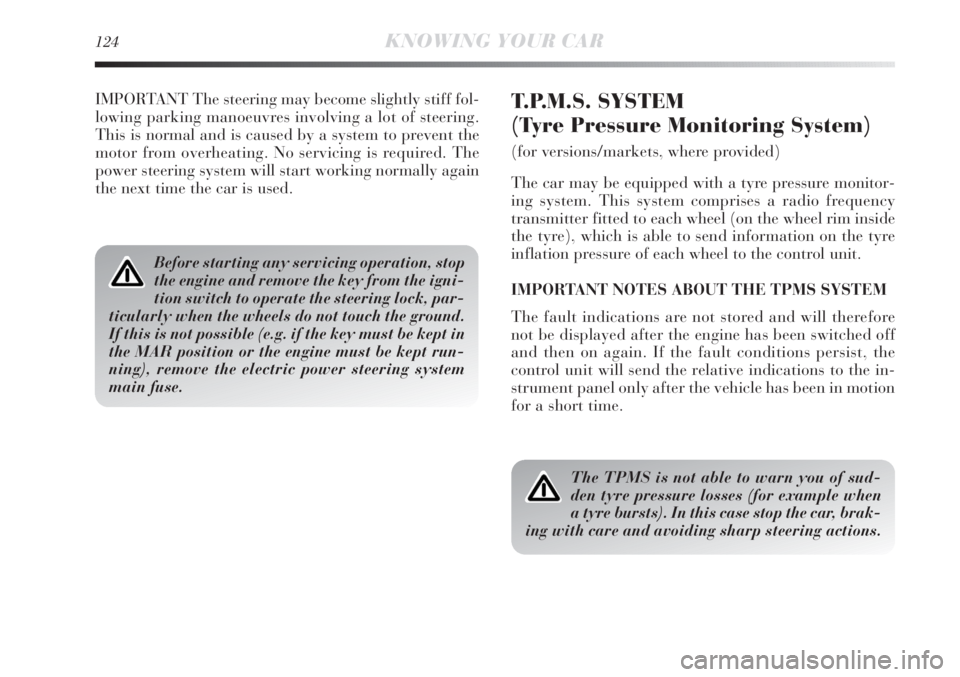
124KNOWING YOUR CAR
IMPORTANT The steering may become slightly stiff fol-
lowing parking manoeuvres involving a lot of steering.
This is normal and is caused by a system to prevent the
motor from overheating. No servicing is required. The
power steering system will start working normally again
the next time the car is used.T.P.M.S. SYSTEM
(Tyre Pressure Monitoring System)
(for versions/markets, where provided)
The car may be equipped with a tyre pressure monitor-
ing system. This system comprises a radio frequency
transmitter fitted to each wheel (on the wheel rim inside
the tyre), which is able to send information on the tyre
inflation pressure of each wheel to the control unit.
IMPORTANT NOTES ABOUT THE TPMS SYSTEM
The fault indications are not stored and will therefore
not be displayed after the engine has been switched off
and then on again. If the fault conditions persist, the
control unit will send the relative indications to the in-
strument panel only after the vehicle has been in motion
for a short time.
Before starting any servicing operation, stop
the engine and remove the key from the igni-
tion switch to operate the steering lock, par-
ticularly when the wheels do not touch the ground.
If this is not possible (e.g. if the key must be kept in
the MAR position or the engine must be kept run-
ning), remove the electric power steering system
main fuse.
The TPMS is not able to warn you of sud-
den tyre pressure losses (for example when
a tyre bursts). In this case stop the car, brak-
ing with care and avoiding sharp steering actions.
Page 126 of 290
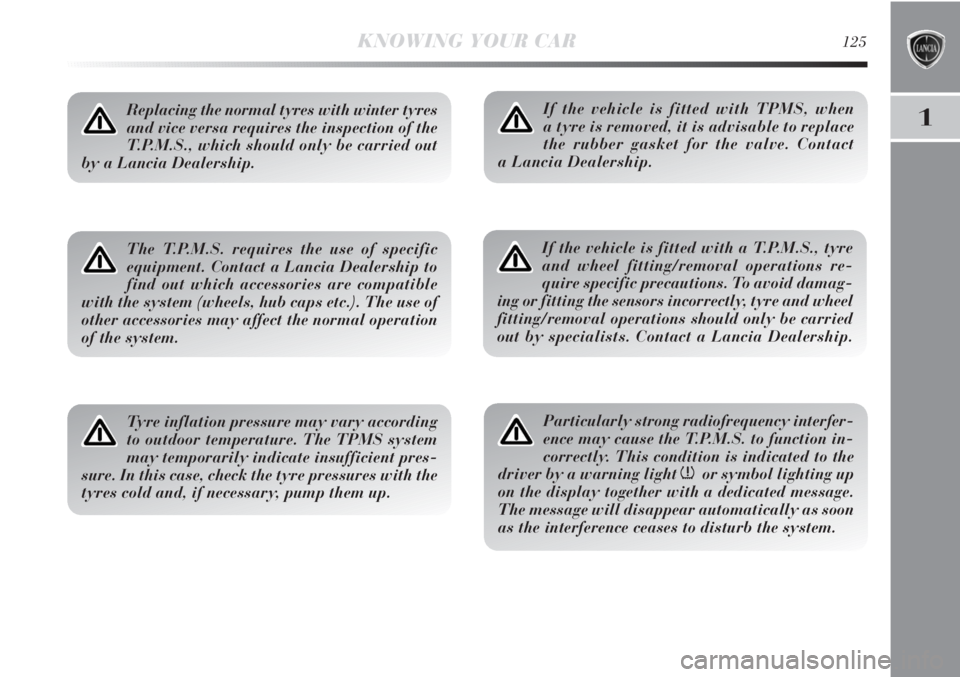
1
KNOWING YOUR CAR125
Replacing the normal tyres with winter tyres
and vice versa requires the inspection of the
T.P.M.S., which should only be carried out
by a Lancia Dealership.
The T.P.M.S. requires the use of specific
equipment. Contact a Lancia Dealership to
find out which accessories are compatible
with the system (wheels, hub caps etc.). The use of
other accessories may affect the normal operation
of the system.
Tyre inflation pressure may vary according
to outdoor temperature. The TPMS system
may temporarily indicate insufficient pres-
sure. In this case, check the tyre pressures with the
tyres cold and, if necessary, pump them up.
If the vehicle is fitted with TPMS, when
a tyre is removed, it is advisable to replace
the rubber gasket for the valve. Contact
a Lancia Dealership.
If the vehicle is fitted with a T.P.M.S., tyre
and wheel fitting/removal operations re-
quire specific precautions. To avoid damag-
ing or fitting the sensors incorrectly, tyre and wheel
fitting/removal operations should only be carried
out by specialists. Contact a Lancia Dealership.
Particularly strong radiofrequency interfer-
ence may cause the T.P.M.S. to function in-
correctly. This condition is indicated to the
driver by a warning light
nor symbol lighting up
on the display together with a dedicated message.
The message will disappear automatically as soon
as the interference ceases to disturb the system.
Page 146 of 290
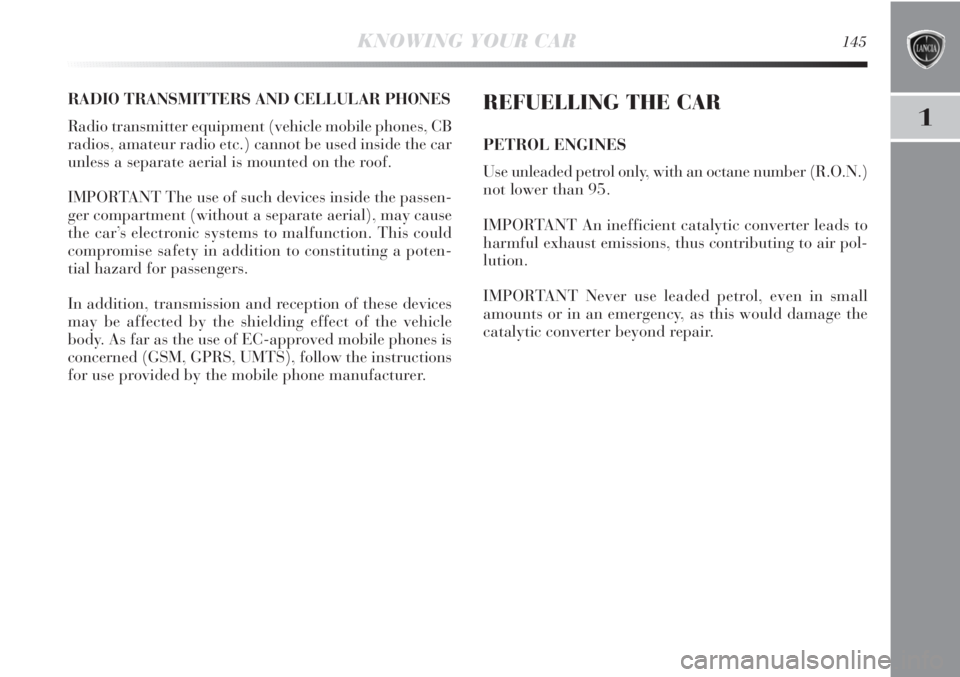
1
KNOWING YOUR CAR145
RADIO TRANSMITTERS AND CELLULAR PHONES
Radio transmitter equipment (vehicle mobile phones, CB
radios, amateur radio etc.) cannot be used inside the car
unless a separate aerial is mounted on the roof.
IMPORTANT The use of such devices inside the passen-
ger compartment (without a separate aerial), may cause
the car’s electronic systems to malfunction. This could
compromise safety in addition to constituting a poten-
tial hazard for passengers.
In addition, transmission and reception of these devices
may be affected by the shielding effect of the vehicle
body. As far as the use of EC-approved mobile phones is
concerned (GSM, GPRS, UMTS), follow the instructions
for use provided by the mobile phone manufacturer.REFUELLING THE CAR
PETROL ENGINES
Use unleaded petrol only, with an octane number (R.O.N.)
not lower than 95.
IMPORTANT An inefficient catalytic converter leads to
harmful exhaust emissions, thus contributing to air pol-
lution.
IMPORTANT Never use leaded petrol, even in small
amounts or in an emergency, as this would damage the
catalytic converter beyond repair.
Page 218 of 290

IN AN EMERGENCY217
4
FUSE SUMMARY TABLE
F12
F12
F13
F13
F31
F33
F34
F35
F36
F37
F38
F39
F40
F417.5
15
7.5
15
5
20
20
5
20
7.5
10
10
30
7.538
38
38
38
38
38
38
38
38
38
38
38
38
38
USERS FUSE AMPS FIGURE
Right dipped beam headlight
Right dipped beam headlight (Xenon gas discharge bulb)
Left dipped beam headlight, headlight alignment corrector
Left dipped beam headlight (Xenon gas discharge bulb)
Climate control system fan relay coil, body computer
Left rear window winder
Right rear window winder
Reversing lights, engine compartment junction unit relay coils,
brake light pedal control (normally closed contact),
water in diesel sensor, air flow meter/control on clutch pedal
and brake servo pressure sensor (1.4 Turbo Multi Air versions)
Central locking system control unit, fuel flap,
dead lock, tailgate release
Third brake light, instrument panel, Adaptive Headlights Node
(1.4 Turbo Multi Air versions excluded), control unit on left hand
gas discharge headlight (1.4 Turbo Multi Air versions excluded)
Front rear and central roof light (for versions/markets where provided,
with electric sun roof), courtesy light on driver’s side and passenger’s side,
luggage compartment light and glove compartment light
Car radio and Radio navigator (1.4 Turbo Multi Air versions excluded),
Blue&Me™ Node, alarm siren, alarm system on roof light,
climate control unit, tyre pressure monitoring system control unit,
diagnosis socket connector, rear roof lights, voltage
stabiliser (1.4 Turbo Multi Air versions without HI-FI option)
Heated rear window
Electric door mirror demisters, demisters on windscreen jets
Page 219 of 290
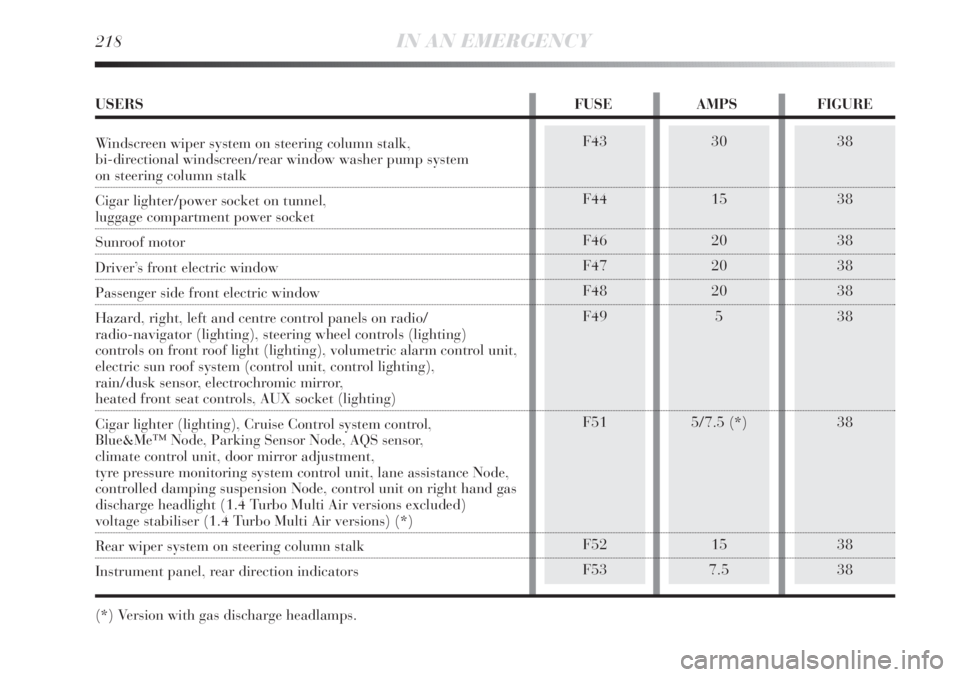
218IN AN EMERGENCY
38
38
38
38
38
38
38
38
38F43
F44
F46
F47
F48
F49
F51
F52
F5330
15
20
20
20
5
5/7.5 (*)
15
7.5
USERS FUSE AMPS FIGURE
Windscreen wiper system on steering column stalk,
bi-directional windscreen/rear window washer pump system
on steering column stalk
Cigar lighter/power socket on tunnel,
luggage compartment power socket
Sunroof motor
Driver’s front electric window
Passenger side front electric window
Hazard, right, left and centre control panels on radio/
radio-navigator (lighting), steering wheel controls (lighting)
controls on front roof light (lighting), volumetric alarm control unit,
electric sun roof system (control unit, control lighting),
rain/dusk sensor, electrochromic mirror,
heated front seat controls, AUX socket (lighting)
Cigar lighter (lighting), Cruise Control system control,
Blue&Me™ Node, Parking Sensor Node, AQS sensor,
climate control unit, door mirror adjustment,
tyre pressure monitoring system control unit, lane assistance Node,
controlled damping suspension Node, control unit on right hand gas
discharge headlight (1.4 Turbo Multi Air versions excluded)
voltage stabiliser (1.4 Turbo Multi Air versions) (*)
Rear wiper system on steering column stalk
Instrument panel, rear direction indicators
(*) Version with gas discharge headlamps.
Page 220 of 290
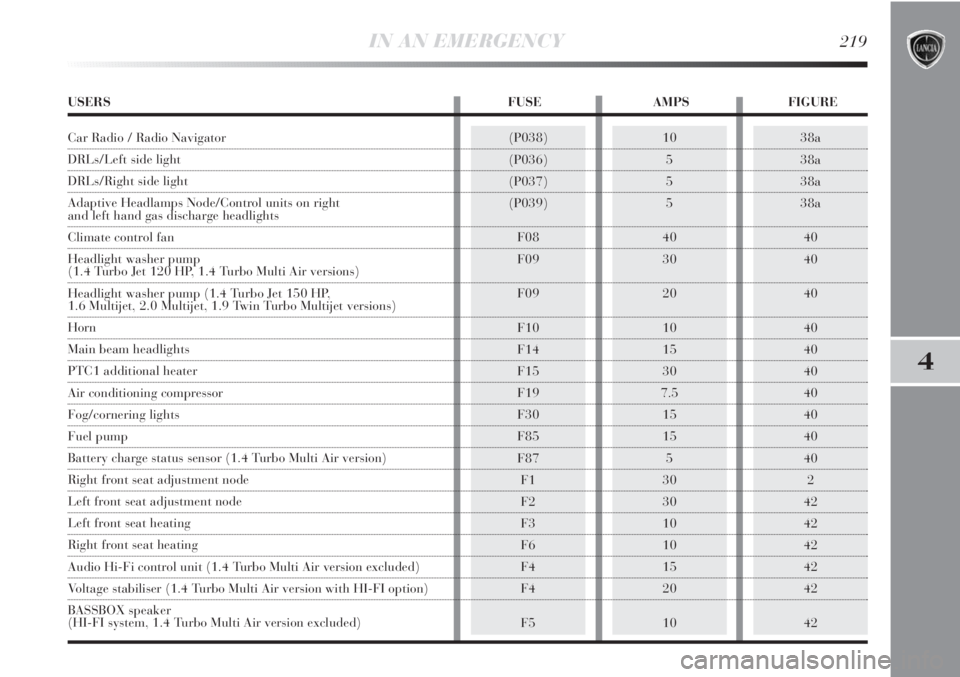
IN AN EMERGENCY219
4
38a
38a
38a
38a
40
40
40
40
40
40
40
40
40
40
2
42
42
42
42
42
42(P038)
(P036)
(P037)
(P039)
F08
F09
F09
F10
F14
F15
F19
F30
F85
F87
F1
F2
F3
F6
F4
F4
F510
5
5
5
40
30
20
10
15
30
7.5
15
15
5
30
30
10
10
15
20
10
USERS FUSE AMPS FIGURE
Car Radio / Radio Navigator
DRLs/Left side light
DRLs/Right side light
Adaptive Headlamps Node/Control units on right
and left hand gas discharge headlights
Climate control fan
Headlight washer pump
(1.4 Turbo Jet 120 HP, 1.4 Turbo Multi Air versions)
Headlight washer pump (1.4 Turbo Jet 150 HP,
1.6 Multijet, 2.0 Multijet, 1.9 Twin Turbo Multijet versions)
Horn
Main beam headlights
PTC1 additional heater
Air conditioning compressor
Fog/cornering lights
Fuel pump
Battery charge status sensor (1.4 Turbo Multi Air version)
Right front seat adjustment node
Left front seat adjustment node
Left front seat heating
Right front seat heating
Audio Hi-Fi control unit (1.4 Turbo Multi Air version excluded)
Voltage stabiliser (1.4 Turbo Multi Air version with HI-FI option)
BASSBOX speaker
(HI-FI system, 1.4 Turbo Multi Air version excluded)
Page 242 of 290

SERVICING AND MAINTENANCE241
5
USEFUL ADVICE FOR EXTENDING
THE LIFE OF YOUR BATTERY
To avoid draining your battery and make it last longer,
observe the following instructions:
❍when you park the car, ensure the doors, tailgate and
bonnet are closed properly, to prevent any light from
remaining on inside the passenger’s compartment;
❍turn off the roof lights, although the car does have an
automatic system for switching off internal lights;
❍do not leave devices (e.g. car radio, hazard lights, etc.)
switched on for a long time when the engine is not
running;
❍before performing any operation on the electrical sys-
tem, disconnect the negative battery cable;
❍battery terminals should always be perfectly tight-
ened.
IMPORTANT If the charge level remains under 50% for
a long time, the battery is damaged by sulphation, re-
ducing its capacity and starting attitude.The battery will also be more at risk of freezing (this can
happen as early as −10 °C). In the case of prolonged idle-
ness, refer to the paragraph “Car inactivity”, in chapter
“3”.
If you decide to install electrical accessories after the car
has been purchased which require a permanent electric
power supply (alarm, etc.) or accessories which have
a serious impact on the electrical balance, seek assistance
from a Lancia Dealership because their qualified staff will
suggest the most suitable Lancia Lineaccessori devices
and assess the overall electric consumption, checking
whether the car’s electrical system can cope or whether
a more powerful battery is required.
Since these devices continue to consume energy even when
the engine is off, they gradually run down the battery.